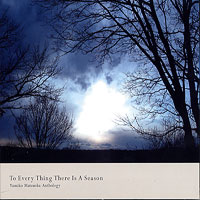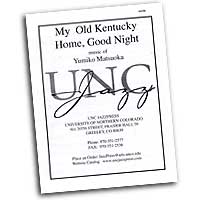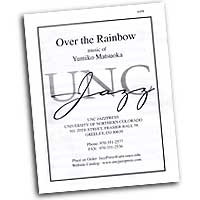|
I am probably one of the luckiest people around, in the sense that I get to do what I enjoy tremendously, and somehow make a living. It all started when I heard the Singers Unlimited's Christmas album on the radio in Japan, back when I was in high school. The amazing sound of Alfred Burt's and Gene Puerling's arrangements and their impeccable blend absolutely blew me away, and the impact was so strong that 1) I had to find out what they were doing to create those chords, and 2) I told myself that one day I would try to do what they were doing. Thus began my long journey to a cappella writing and singing. It took a lot of turns unrelated to a cappella, or even music, but I feel that everything I encountered or got to do on the way has helped me shape my sound.
So how does one go about writing contemporary (as opposed to classical)
a cappella arrangements? I'm not about to offer a definitive answer to
this question, nor do I have the space to go into the details of writing
techniques. But maybe I can give some tips to my fellow a cappella-heads
who aspire to write for their own group, friends and relatives.
The first point that comes to my mind is the choice of songs. A song
has to speak to me at a deep level in order for me to want to write an
arrangement. It could be the lyrics, melody, chord progression, rhythm,
any combination of the above, or something even more intangible. Anyway,
it has to inspire me one way or another. (I truly admire songwriters who
can create those wonderful songs from scratch!)
There are times, however, where a client asks you to arrange a particular
song, rather than lets you choose one. I remember a time where Vox One
was hired to sing at a wedding reception, and was asked to arrange a specific
song for the occasion. I volunteered to write, but it wasn't a song I
really liked, and the result was (at least in my mind) mediocre. It never
entered our permanent repertoire. But most of the time, if you keep an
open mind, you can find something good about a song and a seed of inspiration
can go a long way.
After a song is chosen, I let my mind come up with some ideas for it.
Or rather, let the song play with my imagination to create some musical
fragments. While making a song sound more or less like an original can
be a valid and fun exercise, I'm not partial to that type of arranging.
I would like to add something new to it, modify it, and enhance it so
that what is already wonderful is given a fresh angle and it shines in
a different way. Some songs may be harder than others to do so, because
the original is arranged and performed in such a manner that it's almost
impossible to give it a new life and make it equally engaging. That's
another aspect of choosing a song which needs careful consideration. One
should pick a song that is great, yet has the potential to be molded anew.
Folk songs are some of the best materials, I think, because the melodies
are often beautiful and the chord progression simple that they allow for
much room to play with. Furthermore, most of them are in the public domain
meaning that you are free to record and publish your arrangements without
having to pay royalties.
How can I let the song help me create new ideas, you might ask. For
that to happen, you have to build a catalogue of sounds and ideas that
you like (and to a certain extent, what you dislike). In order to do that,
you have to start listening critically to what you hear. In some ways,
it takes away the fun of listening to the music, but it's a very important
step in building one's own music vocabulary. If you like what you hear
but don't exactly know what it is, transcribe it. It can be frustrating
at first - so start small - but once you get the hang of it, it can be
addictive.
I have had the privilege of getting acquainted with quite a few Japanese
college students who are big fans of Vox One, and almost every one of
them tells me that he/she has transcribed a number of our music (so that
they could sing them)! Instead of leaving the task to one person, each
group member takes on one part, and they bring it together. I was very
impressed by their efforts, even if they may not have been quite accurate.
As an arranger, you have to be able to look at the big picture, so you
can't necessarily ask someone else to do one or more parts for you, but
trust me, the reward is big. I can't tell you how much I've learned from
transcribing Gene Puerling. The secret is that you learn what works from
within, rather than from what a book or a teacher might tell you. By the
way, the source doesn't necessarily have to be vocal music either (or,
for that matter, strictly contemporary). I would name the Beatles and
Debussy to be some of my other teachers - with the former, probably more
for their instrumental lines and phrases than the vocals
It might also help to write out the lyrics on a separate sheet. Read
the poem and let it speak to you. I have a few arrangements where I did
that first and it gave me a new perspective to those songs. This way,
you could come up with a new concept for the arrangement, rather than
just ideas. Knowing whom you are writing for is another advantage. You
can write in such a way to let each person in that group shine.
With an idea (which could be as tiny as just a chord) I sit down at
my keyboard (alas, I don't have a room for a piano!) and start fooling
around. Sometimes it happens and sometimes it doesn't. When it happens,
for me, it's God at work, because in retrospect I can never understand
how I've managed to create something that actually sounds good. After
the arrangement is done, it takes on a life of its own. It's not necessarily
easy when I'm in the middle of it, but somehow I get done unscathed. And
it's one of those precious moments that you completely forget where you
are - hours seem like minutes, and you're flowing in it so freely, even
when you're struggling. On the other hand, when it doesn't happen, I write
down the fragment so that I wouldn't forget it, and come back another
time.
Ultimately, my goal is to create music that means something to some
people; if possible, something that could heal. If I could rework an already
beautiful song and give it a new light (instead of killing it!) my mission
is accomplished.
So, welcome aboard, aspiring writers! I hope our paths cross one of these
days.
|






